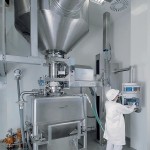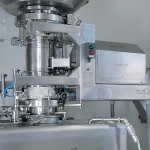The pharmaceutical manufacturer Merck & Cie AG in Switzerland processes numerous active pharmaceutical ingredients (API) from which it manufactures various products in powder form. To fill bags and containers with some of these products, the company needed a closed system that assured effective operator protection, amongst other things.
At the Altdorf production site of pharmaceutical manufacturer Merck, product needed to be transferred from the dryer to a sieve mill and then filled into a container and polyethylene bags on a continuous liner system. This process also includes weighing. The Merck specifications called for:
- A closed system to ensure dust-free transfer, dust-free filling of the bulk commodity and effective operator protection
- Granulation of the product exiting the dryer to a defined particle size for further processing
- Operation of the system as a stand-alone unit capable of being connected to the customer’s process control system
- Installation of the system in an ATEX Zone 1/21 clean room
The following requirement was stipulated for the overall system: the intermediate and final products had to be protected according to the latest good manufacturing practice (cGMP) directives. Merck charged Frewitt with implementing the project. As there was not sufficient space to install the filling area directly underneath the double cone dryer, it had to be arranged adjacent to it. Merck and Frewitt chose an intermediate bulk container (IBC) to transfer the product flexibly from the dryer to the filling system. Thanks to the IBC, the dryer can always be emptied independently of the filling process.
Before the product can be filled into the container, it must be de-agglomerated after exiting the dryer and reduced to particles of a defined size. The ConiWitt 200 conical sieve mill was integrated in the system for this purpose. The high containment directives also made it necessary to integrate a DN 250 active and passive valve system between all main components, namely the double cone dryer, the ConiWitt and the container. The ConiWitt was mounted on a lifting column in order to provide the necessary safe operating distance and prevent the rotating double cone dryer from colliding with the mill during the drying process. An active valve (static component) was installed at the inlet and outlet of the sieve mill, while passive valves were fitted on the mobile units of the dryer outlet as well as at the inlet and outlet of the container. The products are filled into the container automatically.
In the first step, the ConiWitt conical sieve mill is docked to the dryer outlet via the passive-active valves with the help of the lifting column. The mobile container is then manually positioned under the ConiWitt. To achieve a dust-tight connection of the ConiWitt to the container, the active valve is lowered onto the container inlet by means of a pneumatic cylinder. The system is hermetically sealed as soon as all components are connected together. This provides the conditions required for emptying the double cone dryer in an inert environment.
Merck chose the ConiWitt for de-agglomeration. The optimised processing characteristics, enabling a high flow rate (25 % increase in active sieve surface compared to conventional sieve mills) and easy integration in entire installations thanks to the modular concept, were important factors in making this choice. The ergonomic design of the adjustable height base plus the fact that the milling head and lip seal are easy to change were also decisive factors. Moreover, the error-proof system makes it impossible to install the sieve incorrectly.
Change management during the project
Even the best possible planning can never completely rule out structural changes to system design projects due to external influences. The Merck facility was no exception. At the beginning of the project, the intention was to monitor the weight of the container with a floor scale, in order to ensure that the container was completely emptied. For safety and hygienic reasons, however, Merck opted for a mobile container with built-in load cells. Frewitt consequently designed a unit with heavy-duty steering and fixed casters, and integrated four load cells between the base and the container. The result: a mobile container capable of being connected to the stationary weighing system by an Ex connector and accurately weighed prior to filling. Not only is this mobile system safer and more hygienic than the floor scale alternative, it also enables rapid, clean emptying of the entire double cone dryer load.
To fill the market packages, the IBC must first be raised or lowered to the correct height, then pivoted and precisely positioned over the filling system by the lifting column. Dust-free filling of the inliner bags with the product is possible after docking via the passive-active valves. As certain raw materials and active ingredients exhibit sluggish flowing and bridge forming properties, Frewitt installed a Profit-Sword in the inlet of the filling system. This discharge device ensures a constant product flow. The metering valve allows rapid metering when fully opened and precision metering (as little as 10 g) when opened very slightly, even for products with sluggish flow behaviour. Filling with the ProFi-Dos is gravimetric: the product falls directly into the package, which is placed underneath on a scale with a built-in vibration table. The entire filling process takes place automatically. The only manual operation is changing the packages or bags. The system and the aforementioned elements are controlled from a terminal. Another important element is the dedusting filter, which assures vacuum suctioning of gas media and the removal of dust particles via the ProFi-Vent leakproof ventilation system. To make cleaning easier, the pipe couplings and the various system component couplings are configured either as Tri-Clamp connections or as quick clamping devices.
Regulation of the oxygen content
The dryer emptying system and the filling system with the bags to be filled are nitrogen inerted. The appropriate valves and pressure regulators were included in the scope of the order. Sterile filtered nitrogen was furnished by the customer. Gas compensation is provided in the container when cardboard boxes are filled. Excess pressure during inliner inertisation or inflation of the bags is also relieved via the gas compensation pipe. There is no active exhaust air ventilation or exhaust air filtering. The gas compensation pipe is laid in such as way as to prevent the product from building up and clogging. After every product change, the entire system is thoroughly WIP cleaned from top to bottom while in the closed containment state. The continuous rotation of the spray balloon ensures intensive cleaning of the entire filling system, including the docked container. The contaminated liquid is drained via the chemical wastewater pipe (CAW). Both systems are nitrogen dried after wet cleaning.
cpp 453
High containment
Powtech 2008
Share:









